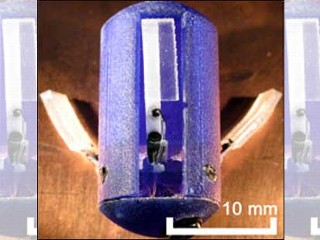 Throughout the history of mankind, we have always wondered what goes on inside our bodies. Way back in the 1500's Leonardo DaVinci set our understanding of anatomy in motion with his anatomy drawings of the body. It wasn't until 1895 when the X-Ray was invented when we could actually look beyond the skin and see inside a living human being. Now in modern day hospitals, there are a wide variety of tools that doctors can use to diagnose and treat different health problems. We can access images of the internal body systems that many believed were not possible.
Throughout the history of mankind, we have always wondered what goes on inside our bodies. Way back in the 1500's Leonardo DaVinci set our understanding of anatomy in motion with his anatomy drawings of the body. It wasn't until 1895 when the X-Ray was invented when we could actually look beyond the skin and see inside a living human being. Now in modern day hospitals, there are a wide variety of tools that doctors can use to diagnose and treat different health problems. We can access images of the internal body systems that many believed were not possible.
 The CT and MRI are not really new technologies (invented in 1972 and 1973) but they are invaluable sources of detailed internal images of our body. CT and MRI scanners use X-Ray and radio waves to look into the depths of our internal structures and a technician can identify a wide variety of internal problems,from internal bleeding to broken bones to cancers and tumors, they all can be quickly and accurately observed for rapid treatment. With these scanners they remove the need for operations to reveal internal problems. because they are non-invasive forms of observation. CT and MRI Scanners technology has been constantly been improved since it's invention to provide safer and more comfortable service for the patient and will continue to play a major part in hospitals and rapid patient assessment.
The CT and MRI are not really new technologies (invented in 1972 and 1973) but they are invaluable sources of detailed internal images of our body. CT and MRI scanners use X-Ray and radio waves to look into the depths of our internal structures and a technician can identify a wide variety of internal problems,from internal bleeding to broken bones to cancers and tumors, they all can be quickly and accurately observed for rapid treatment. With these scanners they remove the need for operations to reveal internal problems. because they are non-invasive forms of observation. CT and MRI Scanners technology has been constantly been improved since it's invention to provide safer and more comfortable service for the patient and will continue to play a major part in hospitals and rapid patient assessment. Not all medical technology is as impressive as the MRI and CT scanners, in fact just as important medical improvements have been on the small side. The external artificial pacemakers was developed by Canadian John Hopps in 1950 and was improved to be an internal device in 1958. These little guys help keep the beat when the heart becomes weaker and cannot keep up with the demands of the body. A pacemaker works by monitoring your heart rate with sensors, when the heart is needed to speed up or slow down, the pacemaker sends an electronic impulse to an electrode on the heart which causes the heart to contract. Newer pacemakers even monitor your body temperature and breathing and adjust to what ever demands are required for the heart, so a patient isn't restricted from physical activities.
Not all medical technology is as impressive as the MRI and CT scanners, in fact just as important medical improvements have been on the small side. The external artificial pacemakers was developed by Canadian John Hopps in 1950 and was improved to be an internal device in 1958. These little guys help keep the beat when the heart becomes weaker and cannot keep up with the demands of the body. A pacemaker works by monitoring your heart rate with sensors, when the heart is needed to speed up or slow down, the pacemaker sends an electronic impulse to an electrode on the heart which causes the heart to contract. Newer pacemakers even monitor your body temperature and breathing and adjust to what ever demands are required for the heart, so a patient isn't restricted from physical activities. The Smart Pill and Gut Bot have been introduced as new ways to study the digestive system. Both can be swallowed by a patient and use cameras and sensors to measure variables like pH level, temperature and pressure inside the gastrointestinal tract. The pills can send information to the doctor or it can preform small tasks like release drugs, or remove cells for study. The research team behind the Gut Bot is also confident that in the future the robot will be able to use lasers and treat internal injuries.
The Smart Pill and Gut Bot have been introduced as new ways to study the digestive system. Both can be swallowed by a patient and use cameras and sensors to measure variables like pH level, temperature and pressure inside the gastrointestinal tract. The pills can send information to the doctor or it can preform small tasks like release drugs, or remove cells for study. The research team behind the Gut Bot is also confident that in the future the robot will be able to use lasers and treat internal injuries.As we continue on the road of constant technological advances, our understanding of ourselves have been greatly affected. As new developments come in, you can help but wonder, what will tomorrow bring?
Sources
http://www.historyworld.net/wrldhis/PlainTextHistories.asp?groupid=46&HistoryID=aa05>rack=pthc
http://www.nhlbi.nih.gov/health/dci/Diseases/pace/pace_howdoes.html
http://www.nhlbi.nih.gov/health/dci/Diseases/pace/pace_howdoes.html
http://www.sciencedaily.com/releases/2011/04/110414131652.htm
http://www.smartpillcorp.com/index.cfm?pagepath=Products/The_SmartPill_Capsule&id=17814
http://www.technologyreview.com/biomedicine/17470/?mod=related&a=f
http://technologyreview.com/biomedicine/21153/?a=f
Comments
http://bridgettebioblog.blogspot.com/2011/03/technology-whats-in-it-for-you.html?showComment=1303911834605#c64528249182794525
http://sbi3u1carminachu.blogspot.com/2011/03/importance-of-technology-to-understand.html?showComment=1303912539685#c4218968294606665290
http://www.smartpillcorp.com/index.cfm?pagepath=Products/The_SmartPill_Capsule&id=17814
http://www.technologyreview.com/biomedicine/17470/?mod=related&a=f
http://technologyreview.com/biomedicine/21153/?a=f
Comments
http://bridgettebioblog.blogspot.com/2011/03/technology-whats-in-it-for-you.html?showComment=1303911834605#c64528249182794525
http://sbi3u1carminachu.blogspot.com/2011/03/importance-of-technology-to-understand.html?showComment=1303912539685#c4218968294606665290

Hello,
ReplyDeleteI genuinely loved this brilliant article. Please continue this awesome work. Thumbs up, and keep it going!
Alkaline Phosphatase Assay Kit
Thanks!
Mark Holland